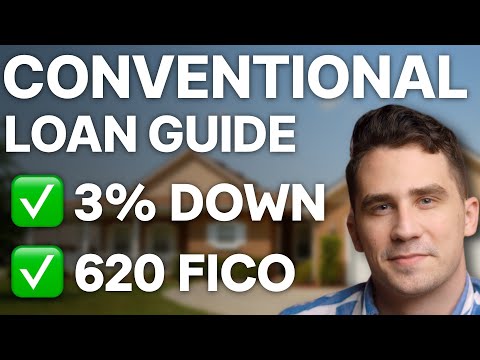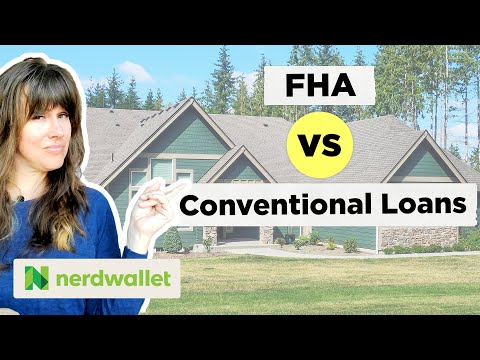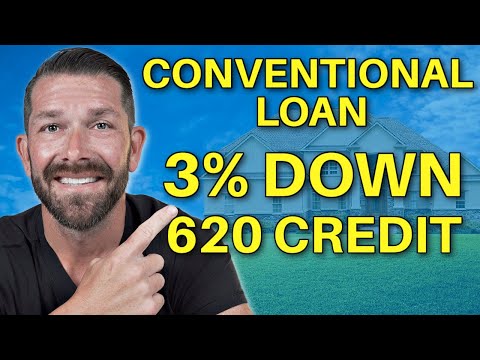Navigating the mortgage market can be as tricky as trying to shop white Sneakers at a mud run, but when it comes to the bedrock of home financing, the conventional home loan remains a formidable path to homeownership. As we step into 2024, let’s lace up and uncover the secrets of a conventional home loan, equipping you with the savvy of Suze Orman and the financial fortitude of Robert Kiyosaki.

Deciphering What is a Conventional Loan and Its Advantages
A conventional home loan is like the Swiss Army knife of the mortgage world; versatile and not part of any government program. It can be your ticket to buying a dream home without the need for backing from Uncle Sam. Now, you might be wondering, “What’s cooking with conventional loans in today’s market?” It’s all about choice and potential for borrowers who have their financial ducks in a row.
Conventional loans stand apart from those government-backed cousins, the FHA and VA loans. Sure, government loans might seem like a warm hug with their often-lower down payment requirements, but don’t forget everything comes with a price tag. As we saw last November, the FHA’s got more fees than a high school with extra-curricular galore, balancing out any sweet savings you thought you had on interest rates.
In contrast, conventional loans play the long game – think chess, not checkers. They may look steeper at the get-go, especially with closing costs that don’t pull their punches, but if you’ve got the means to meet the initial demands, you’re setting sail on a voyage with fewer expenses down the stream.

Exploring the Conventional Home Loan Requirements in Detail
Alright, let’s dive into the brass tacks of conventional loan requirements. Picture this: It’s 2024, and these loans don’t just walk into your life; they expect you to wine and dine them with a credit score that’s not slumming it. We’re talking a minimum of 620, folks – quality over quantity, right?
The down payment is next up to bat. We’ve all heard the mantra ‘20% or bust,’ which still rings true if you want to dodge the PMI – that pesky Private Mortgage Insurance. But wait, there’s a twist! In these modern times, you can sneak in the door with a minimal 3% down if your credit score doesn’t offend the loan gods. Remember, more down now means less to frown about later.
Now let’s chew the fat on Debt-to-Income (DTI) ratios. It’s as serious as a Monday morning: keep it at 43% or below if you want the lenders to give you a nod. Your employment and dough need to be as solid as a wild growth oil business – stable and verifiable. And the house itself? It’s got to shine under the appraisal spotlight, meeting all the standards so the lenders can rest easy.

| Category | Details |
|---|---|
| Type of Loan | Conventional Home Loan |
| Definition | A mortgage not insured or guaranteed by the government, offered through private lenders or government-sponsored entities. |
| Loan Entities | – Private lenders – Fannie Mae – Freddie Mac |
| Conforming vs. Non-Conforming | – Conforming loans meet guidelines set by Fannie Mae and Freddie Mac. – Non-Conforming loans do not meet these guidelines. |
| Minimum Credit Score | Typically 620 or higher, with 740 for better rates and lower down payments. |
| Interest Rate | Determined by lender, influenced by credit score |
| Mortgage Insurance | Required if down payment is less than 20%. |
| Debt-to-Income Ratio | Generally 43% or lower |
| Down Payment | – Minimum 3%; higher percentages may be required based on credit and DTI. – 20% recommended to avoid mortgage insurance. |
| Closing Costs | Typically lower than government-backed loans but required to be paid upfront without much flexibility. |
| Flexibility | Less flexible compared to government-backed loans, especially in avoiding upfront fees. |
| Loan Features | – Can be used for primary residence, second homes, or investment properties. – Fixed or adjustable interest rates. |
| Popularity | Most common type of mortgage loan. |
| Benefits | – No government-imposed limits on loan amounts. – Potentially lower cost than FHA loans over the life of the loan. |
| Considerations | – More stringent qualification requirements. – Higher down payment or credit score may be necessary to secure best terms. |
Navigating Interest Rates and Loan Terms for Conventional Loans
Interest rates can have you feeling like you’re riding a rollercoaster in the dark, but here’s the lowdown: Conventional loans offer both fixed-rate and adjustable-rate mortgages (ARMs), setting the stage for a financial plan that fits you like a best gym bag – compact, convenient, and catering to your needs.
Do the math and you’ll see the significance of loan term choices. Be it 15-year, 20-year, or the good old 30-year loan, each comes with its own flavor. Shorter terms mean less interest paid in the long run, but higher monthly payments. Long terms – lower monthly payments, but more interest over time.

The Insider’s Guide to Loan Size Limits and Jumbo Loans
Now, don’t get your wires crossed; not all conventional loans are created equal. There are your conforming loans, which play Marco Polo within the loan limits set by the FHFA – think of it as a financial pool they’re not allowed to swim out of. And then, there are the jumbos, the big kahunas that stride past those limits with their heads held high.
You waltz into jumbo territory when you’re eyeing a property that’s got more digits in its price tag than your phone number. Getting your hands on a jumbo conventional loan is like snagging backstage passes – it’s a bigger deal, requiring more financial muscle and often, a heftier down payment.

How Private Mortgage Insurance (PMI) Works with Conventional Loans
Alright, let’s hash out PMI. If your down payment is skinnier than 20%, PMI becomes a tag-along on your loan journey. The cost? It’s a bit like crest whitening Strips for your mortgage – a small price for a brighter outcome (read: homeownership). Now, don’t you fret; PMI isn’t forever. Once you’ve built up enough equity, you can kick it to the curb, just like that freeloader roommate after college.
Exclusive Tips for Streamlining the Conventional Loan Application Process
Here’s a pro tip: Arm yourself with a dossier of paperwork that’d make a Rockstar sign in with envy. Tax returns, pay stubs, bank statements – get them all lined up for the big show. Pre-approvals are your best friend; they’re like a backstage pass that whispers to sellers,This one’s legit.
Working with a mortgage broker can be like having a GPS in the world of conventional loans. Sure, you might ride solo, but these pros can navigate through the choppy waters, potentially snagging you a sweet deal. And don’t just take my word for it; quick peeks into the case studies from mavens at Quicken Loans and Wells Fargo will tell you the same.
Advanced Strategies to Optimize Your Conventional Loan Package
Time to level up – this ain’t amateur hour. If you’re sitting pretty with home equity, you’re holding a golden ticket. Tap into that nest egg with a HELOC or cash-out refinance if the situation calls for it, but tread carefully.
Mortgage points are the secret sauce to trimming down your interest rate, a bit like how you rationalize paying a premium for pax era pro – it’s all about the quality, baby.
As for negotiating lender fees and closing costs, don’t be shy. That price tag isn’t set in stone, and with the right moves, you might just dance away with a deal that’ll have you grinning all the way to your new front door.
Conclusion: Harnessing the Power of Conventional Home Loans for Financial Success
So there you have it, fine folks – the skinny on conventional home loans and how they can be a game-changer in your financial playbook. They’re not just about borrowing dough; they’re a fully-fledged strategy for financial success. Keep your eye on the big picture, not just on the dotted line.
Consider the entire orchestra – the monthly payments, the interest, the terms – and how they harmonize with your personal financial symphony. Thinking about How To stop foreclosure? A well-chosen conventional loan can be the cornerstone of a fortress against such woes.
With the keys to understanding what is a conventional loan firmly in hand, you’re all set to conquer the mountain of homeownership. Just remember, in the end, it pays to do your homework – study the purchase agreement, master the difference between Fha And conventional, and above all, play your cards like you’ve got a royal flush hiding in your sleeve. Here’s to your success – may your home loan journey be as rewarding as the sanctuary it secures.
Unlocking the Mysteries of a Conventional Home Loan
When diving into the world of homeownership, the term “conventional home loan” might pop up more often than a prairie dog in your backyard. Conventional loans are the bread and butter of the mortgage world, but that doesn’t mean they’re as plain as white toast. Let’s serve up some fun trivia and interesting tidbits that’ll make you the life of any (financially savvy) party!
The Points Game in Conventional Loans
Ever heard of a discount without shopping? Welcome to the world of home loans, where What are discount Points on a mortgage is not just a question, but a strategy! Here’s the scoop: discount points are like prepaid interest—you shell out some cash upfront to lower your interest rate over the life of your loan. It’s like buying your loan’s “on sale” label, and who doesn’t love a bargain?
Now, imagine attending your neighbor’s BBQ and casually dropping, “Just bought a few discount points on my mortgage—nabbed a lower interest rate and long-term savings.” Watch as the grillmaster’s tongs drop in awe.
Conventional Wisdom Says Size Matters… In Loan Limits
Bigger isn’t always better. With conventional home loans, there’s a cap on how much you can borrow, called loan limits. These limits change like fashion trends—every year they’re updated. The reason? They’re in tune with the average home price shuffle. There’s a loan limit for every county, and if you fancy a McMansion in a high-cost area, you might just bump into what’s called a “conforming loan limit.” It’s like stretching your sweatpants after Thanksgiving dinner—there’s a limit before things get uncomfortable.
Flying Solo Without the Government
Unlike its cousins—FHA and VA loans—a conventional home loan goes stag to the loan party. It’s not insured or guaranteed by Uncle Sam’s squad but instead struts its stuff backed by private lenders. It’s the independent film of the mortgage world: not backed by the big studios—er, government agencies—but still a box office hit.
Conventional wisdom (see what we did there?) tells us that to snag a conventional loan, you typically need to step up your game with a sturdier credit score and a decent down payment. It’s like trying to impress a first date with more than just your average “Netflix and chill” offer.
The Secret Handshake of the Loan World
Ever feel like there’s a secret club of homeowners who know things you don’t? The conventional home loan might be their handshake. It’s full of jargon that sounds like code: PMI, LTV, DTI. But once you crack it, you’re in the club! PMI (Private Mortgage Insurance) is that buddy that covers the lender’s back if you default, but only if you put down less than 20%—it’s a safety net that lets you join the party without the full cover charge.
Fixed or Adjustable? Choose Your Own Adventure!
Planning ahead like a chess master or living life one day at a time? Conventional home loans cater to both mindsets with fixed and adjustable-rate mortgages (ARMs). A fixed-rate is like your loyal friend—steady and predictable for 15, 20, or 30 years. ARMs, on the other hand, are the wild cards offering lower initial rates that adjust over time—like riding the stock market waves with a surfboard.
Grab your financial surfboard and show ‘em you can ride the ARM wave or cruise steadily on the fixed-rate river. Whatever floats your boat!
From Application to Closing: The Conventional Loan Marathon
From the starting line of application paperwork to the finish line of closing day, getting a conventional loan is a marathon, not a sprint. It might feel like you’re running in gear-heavy armor as you gather financial documents, but crossing that finish line with keys in hand is the victory lap of a lifetime.
Remember, thoroughbred racers don’t carry dead weight. Drop any debt that’s weighing you down to boost your credit score, just like shedding those extra pounds before race day.
A World Without Prepayment Penalties
Dreaming of striking it rich and paying off your home sooner than expected? With most conventional home loans, you can! There are typically no prepayment penalties. So, if you happen to invent the next world-changing gadget or hit the jackpot (fingers crossed), you’re free to pay off your loan faster than a teen eats pizza.
Who knew conventional home loans could be as peppered with surprises as a bestseller mystery novel? Next time you’re lost in mortgage mumbo jumbo, just recall these fun facts and you’ll be the Sherlock Holmes of home loans, deducing the ins and outs with ease. Conventional home loans may not seem like the stuff blockbusters are made of, but with secrets like these, they’re definitely deserving of a red-carpet reveal.

What is a conventional loan on a home?
A conventional loan on a home is like your run-of-the-mill vanilla ice cream—it’s the most common type of mortgage out there. It’s not backed by the government, which basically means it sticks to the Freddie Mac and Fannie Mae rules. Lenders love it because it’s got a pretty standard playbook for how much you borrow and your repayment plan.
What is the downside of a conventional loan?
The downside of a conventional loan, you ask? Well, it’s a bit of a stickler for the rules. You’ll need a decent credit score, a solid income, and some cash for a down payment. If your financial ducks aren’t in a row, this loan might give you the cold shoulder.
Is conventional better than FHA?
Is conventional better than FHA? That’s like asking if a burger is better than a taco—depends on your taste… and your credit score! Conventional loans can boast lower interest rates and no upfront mortgage insurance fees if you’re bringing a hefty down payment to the table.
How hard is it to get a conventional home loan?
How hard is it to get a conventional home loan? It’s not rocket science, but you’ll need your financial act together. Think of it like an exclusive club—good credit, stable job, and a down payment are the bouncers you’ll need to get past.
Why do sellers want a conventional loan?
Sellers dream of a buyer with a conventional loan—it’s like the golden ticket at an auction. Conventional loans often have fewer hoops to jump through, leading to a smoother, quicker closing process.
Do you have to put 20 down on a conventional loan?
Do you have to put 20 down on a conventional loan? Nah, but it sure is a bright idea if you can! Less than 20% down means you’ll probably be on the hook for private mortgage insurance (PMI), adding to your monthly bill.
Is it hard to get approved for a conventional loan?
Is it hard to get approved for a conventional loan? Well, it ain’t easy-peasy if your credit’s squeaky. Lenders want assurance you can cough up the cash, so strong credit and a steady income are your best bets for an approval nod.
Why is it hard to get a conventional loan?
Why is it hard to get a conventional loan? Let’s just say lenders don’t love risk. With stricter guidelines, if your credit score’s sliding towards the shallow end or your savings look a tad threadbare, you might hit a wall trying to get a conventional loan.
What credit score is needed for a conventional loan?
What credit score is needed for a conventional loan? Picture this: 620 is the magic number—at least—it’s where the curtain lifts, but for the best rates, you’ll want to hit that high note, climbing towards 740 or more.
What is the lowest down payment for a conventional loan?
The lowest down payment for a conventional loan? How does 3% sound? There’s a catch, though—you’ll likely be chatting with PMI each month until you’ve hit that 20% equity mark.
Why do people choose conventional over FHA?
Folks pick conventional over FHA for a few solid reasons: potentially lower interest rates, avoiding pesky upfront mortgage insurance costs, and the freedom from FHA’s property standards.
Why do sellers want conventional over FHA?
Sellers go googly-eyed over conventional because it often means fewer hiccups, less chance of the deal tanking, and a faster path to handing over those keys.
How many years of income do you need for a conventional loan?
How many years of income do you need for a conventional loan? Lenders typically want two years of stable earnings under your belt—think of it as a financial background check to ensure you’re good for the money.
Why would I be denied a conventional loan?
Denied a conventional loan, and wondering why? It could be a low credit score, spotty job history, or other debts giving the lender cold feet. It’s like getting turned down for a date—best to know why to improve your chances next time!
What is the max loan amount for conventional?
What’s the max loan amount for conventional? Strap in, because it changes yearly. As of 2023, we’re talking about loans up to $726,200 in most areas, but it can leapfrog up to $1,089,300 in high-cost areas—because let’s face it, some neighborhoods are pricier than a steak at a five-star joint.
What’s the difference between a conventional loan and a regular loan?
Alrighty, conventional loan vs. regular loan—what’s the scoop? Well, ‘regular’ is often another name for ‘conventional,’ just in homespun terms. It’s your standard, non-government-backed mortgage.
What is the difference between a conventional loan and a mortgage?
Conventional loan vs. mortgage, it’s simple: a conventional loan is a type of mortgage—one without the government ties. Think of a mortgage as an umbrella term, while a conventional loan is just one style under it.
Is a conventional home loan good?
Is a conventional home loan good? If your ducks are in a row—credit score strutting high and a decent down payment—it can be as sweet as pie, offering competitive rates and terms.
What is the difference between a conventional and non conventional loan?
Lastly, a conventional loan is like a well-trained dog—it follows a certain set of commands (guidelines), while a non-conventional loan is more like a free-spirited cat—it can be government-backed and plays by different rules, such as lower down payments and credit requirements.



